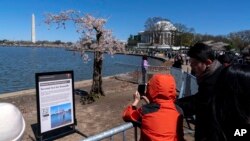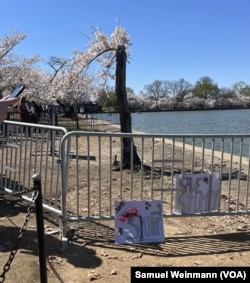Thousands of cherry blossoms began blooming earlier this month in Washington, bringing scores of tourists from around the world to see them at the Tidal Basin. But this year many tourists are coming to see one tree in particular: Stumpy.
Stumpy, a short cherry tree in poor condition, looks like it shouldn't be in any shape to grow blossoms — particularly as floods routinely soak the tree's roots. Every year, however, it blooms, giving the tree a reputation as a symbol of hope, resilience and relatability among its fans.
This year's cherry blossom season will be the last for Stumpy, along with more than 150 other cherry trees. The removal is part of a $113 million project announced earlier this month by the National Park Service to rebuild and raise the seawalls around the Tidal Basin and along part of the Potomac River.
Spurred by climate change, floods have worsened along the basin, now occurring twice a day, soaking the roots of many cherry trees and posing a risk to their health. As a measure to preserve the thousands of cherry trees along the basin, 158 of them will need to be removed to make space for the project.
On Sunday, thousands of visitors arrived at the basin to say goodbye to Stumpy, which was fenced off. Visitors crowded around the fence to take photos of the tree. Some had put up signs on the fence reading "Save Stumpy."
The movement to save Stumpy has gained traction among those who would like to see the tree transplanted. An online petition to save the tree, calling Stumpy "our local cherry blossom hero" collected more than 600 signatures as of Monday.
The Park Service has announced that while it is unfortunate that the cherry trees need to be removed, there is no way around their removal because the agency needs to make space for the project.
According to NBC News, there is no way to save Stumpy either, as it likely wouldn't survive the transplanting process. Mike Litterst, spokesperson for the Park Service, said, "There is so little of that tree left to transplant," adding that even if it could be taken out of the ground, it could die of transplant shock.
A group of tourists visiting Stumpy from Massachusetts and Maryland agreed that although the removal of Stumpy and the other cherry trees will be sad, it's a necessary measure to stem the impacts climate change has had on the basin.
One tourist, who preferred not to give their name, said, "we understand the necessity" of the project, saying "We were here yesterday, and the wind was so strong that it was blowing the waves over the bank, so all of this area [around Stumpy] was flooded."
Another, who also preferred to remain anonymous, said, "It's unfortunate that they're going to lose … [the] trees, especially since some of them are heritage trees … but this isn't the only place where this kind of climate change induced incursion of water is happening."
The Park Service, in a statement released earlier this month, said, "Age, rising sea levels and poor drainage have taken a toll on the Tidal Basin and West Potomac Park seawalls." It added: "As a result of the settling and sea level rise, water flows over portions of the seawalls twice a day during normal tidal conditions," necessitating the project.
Upon completion of the project, set for 2027, 455 trees will be planted, 274 of which will be cherry trees.
The Park Service will also partner with the U.S. National Arboretum to collect clippings and create genetic matches of Stumpy.
The cherry trees were a gift from Japan in 1912 as a symbol of friendship between the U.S. and Japan. Staff at the Japanese Embassy visited the tidal basin last week to honor Stumpy.
The embassy in a post on the X platform thanked the Park Service for caring for the trees over the years, saying that Stumpy is "one of our most beloved symbols of [Japanese-American] friendship." The post added that Stumpy's "legacy will live on, nurturing future generations of friendship."









